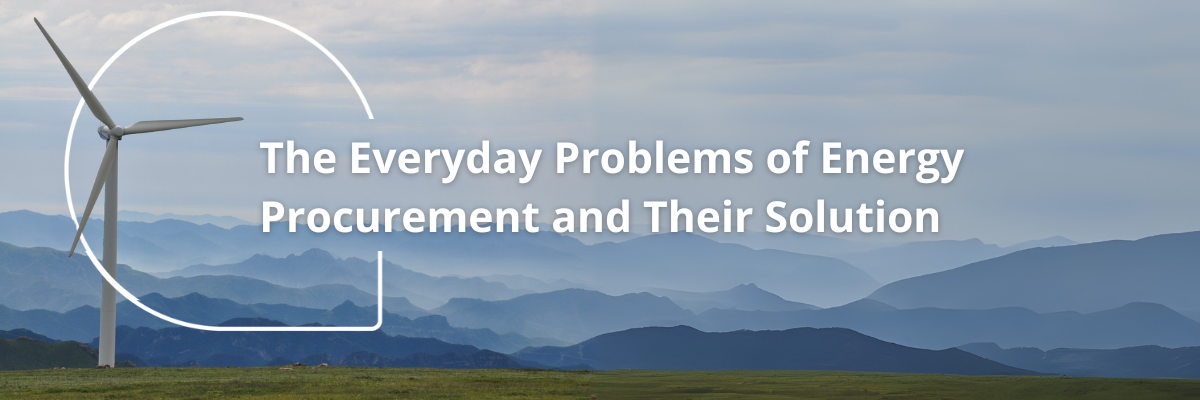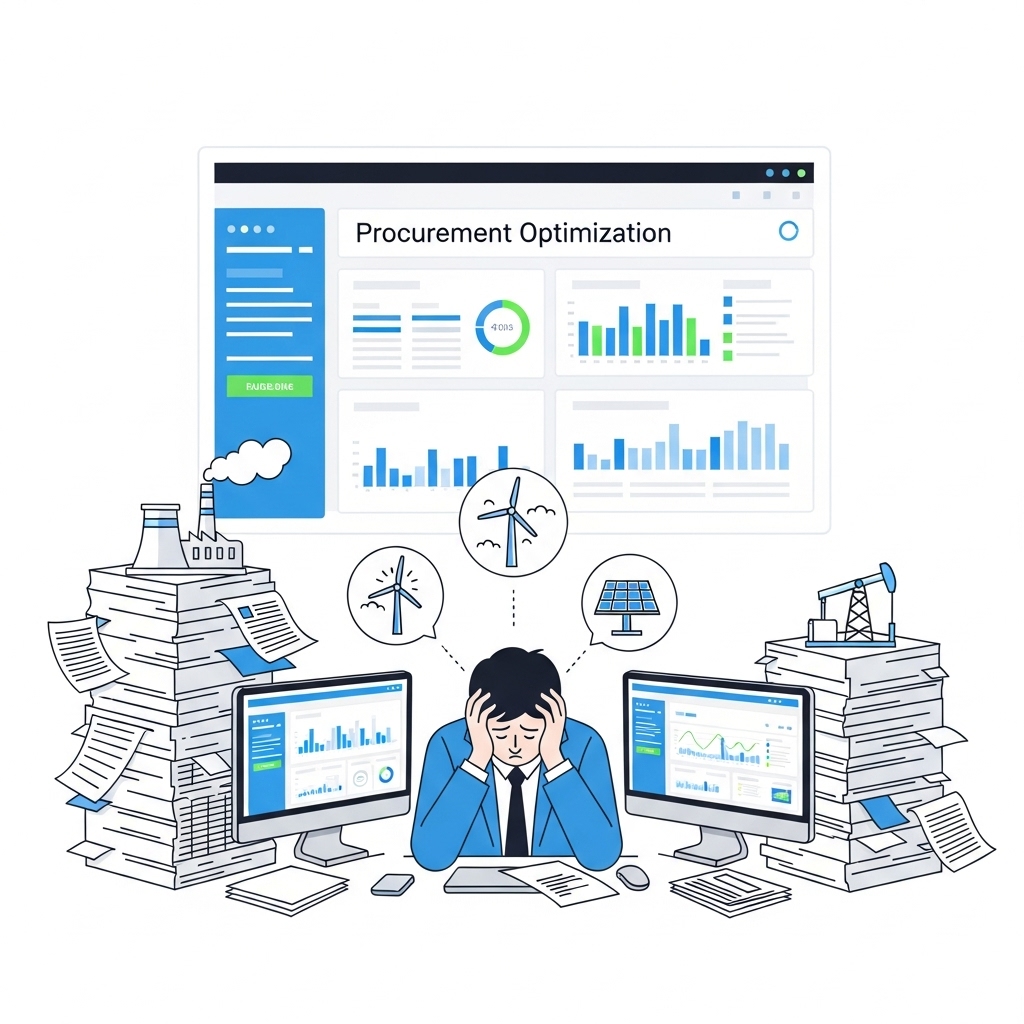Transform Your Energy Procurement Processes Today
Discover industry-specific solutions that cut procurement costs by 15%


A procurement coordinator at a regional energy service provider has 23 unanswered emails sitting in their inbox. The phone rings constantly because a critical transformer replacement requires an emergency procedure at a substation, while their boss is asking: "How much have we spent on maintenance this year?" Finding the answer means at least 2 hours of "data hunting" - if they're lucky.
This is the daily reality for many procurement professionals in Central and Eastern Europe. They must work in an environment where modernizing traditional energy infrastructure, integrating growing renewable energy sources, and maintaining continuous operation of critical systems all demand attention simultaneously - while procurement processes are still based on last decade's tools.
Procurement professionals in the CEE energy sector navigate an extraordinarily complex and rapidly changing environment. This complexity stems from several factors:
Infrastructure Duality: While the region's energy systems still rely heavily on traditional technologies (coal, gas, and nuclear power plants), they must simultaneously prepare for the challenges of increasing energy automation.
Critical Systems: Energy infrastructure procurement operates 24/7 - a poor procurement decision or delayed component acquisition can jeopardize entire regions' power supply.
Regulatory Pressure: Maneuvering through the crossfire of EU energy targets, national energy policies, and local compliance requirements.
Long-term Perspective: While other industries think in 5-10 year cycles, in energy, a 25-40 year perspective is normal. This influences every procurement decision:
In the energy industry, superficial knowledge isn't enough. You need to know not just which supplier offers the best price for a turbine generator, but also whether it can be properly integrated with existing energy SCADA systems, whether it meets strict workplace safety regulations, and how it will perform 20 years from now.
The reality is that every procurement decision must be filtered through a constantly changing, multi-layered requirement system:
The region's energy sector is particularly sensitive to geopolitical changes. The war in Ukraine and the need to reduce Russian energy dependence have fundamentally transformed procurement opportunities. New supplier chains had to be built overnight for critical components. What was stable and reliable for decades suddenly became unavailable or unaffordable.
This is the most painful and common operational problem in the energy sector. A regional power company procurement specialist's day begins trying to compare maintenance service offers across five different Excel spreadsheets. A 60-row, 25-column table where every typo is critical and could jeopardize technical reliability.
"Where is that turbine maintenance contract? In email, on SharePoint, or on someone's local drive?" - This question arises multiple times daily at energy companies. The painful truth is that a simple question - "What was our annual maintenance budget last year?" - requires 3-4 hours of research. Information is scattered across emails, local spreadsheets, and various non-communicating systems.

One of the energy sector's biggest peculiarities is that general standards barely exist. Technical details vary greatly by supplier, making comparison a major headache for procurement departments. Beyond technical specifications, different conditions must be considered. Suppose three offers are on the table for a gas turbine overhaul. All with different warranty conditions, different spare parts supply models, and different risk sharing. How do you compare them objectively?
The energy procurement professional drowns in data and often decides based on the most easily comparable factor - the purchase price - ignoring the much more important total cost of ownership (TCO).
This is perhaps the most stressful aspect in energy. A power plant or substation consists of tens of thousands of special components. The absence of a single critical component worth a few euros can cause production losses of several million euros per hour.
Energy-specific challenges:
In the energy sector, workplace safety is non-negotiable. Every supplier and subcontractor must meet the strictest environmental, health, and safety (EHS) regulations.
In practice, this means endless administration:
And a single missing document results in immediate project shutdown.
In energy, contract management is critically important. Hundreds of maintenance, delivery, and service contracts must be managed in parallel, monitoring expiration dates, performance SLAs, and compliance documents.
A forgotten turbine maintenance contract extension isn't like missing an office paper procurement. This concerns people's power supply and national energy security, which is a serious responsibility.
In the energy sector, waste management is extremely complex. Radioactive waste (nuclear), hazardous chemicals (thermal power plants), or aged equipment (transformers, switches) all require special handling. Procurement doesn't end with buying a new transformer. You need to know how to safely dispose of the old one, who's authorized to handle it, what permits are needed, and the total cost.
The energy sector's unique challenge is the mixing of technological generations. A procurement professional must simultaneously understand:
Energy companies typically have IT infrastructure built decades ago:
When introducing a new, modern procurement software, the operational buyer must navigate between four different systems where data doesn't communicate with each other.
An energy company group's procurement professional needs to see exactly what component requests have entered the system, how long it takes to procure them, which suppliers' performance has declined recently, and at what price and under what conditions these components can be ordered from other suppliers.
A modern energy procurement platform delivers:
Intelligent procurement systems offer different automation levels - from full manual oversight to complete autonomous operation. What's this good for in practice? Here are some examples:
We can set routine, low-value parts to automatically reorder from pre-approved suppliers, while critical, high-value components still require approval decisions.
By analyzing operational data, the system can predict weeks in advance which equipment will need maintenance. The buyer doesn't react to crises but proactively plans procurement.
Natural language queries allow complex questions in simple sentences: "Which suppliers performed above 95% accuracy for turbine parts in the past year?"
Integrated document management eliminates administrative hell. Every supplier certificate, safety document, and compliance certification is automatically tracked.
Guided auction functionality enables quick, transparent competition - critical component procurement can be completed in hours, with clear competition conditions and documented decision processes.
Workflow capabilities make it easy to track daily procurement process bottlenecks and approval status. The list of completed procurements can be queried with one click and provided in reportable format.
CEE region energy sector procurement professionals find themselves at a historic moment. Energy transition, geopolitical changes, and technological development all demand attention simultaneously.
But a power grid operator shouldn't work in constant crisis mode. With professional tools, instead of reactive firefighting, they can achieve proactive energy security strategy; instead of an administrative robot role, they can reach the position of strategic advisor.
The question isn't whether digital transformation is needed in energy procurement. It's who will be first to take this step and free their professionals from the captivity of Excel spreadsheets or opaque systems.
Procurement Software Evaluation Checklist - Detailed checklist to evaluate your software opportunities. The checklist includes:
Download the procurement software evaluation checklist here.